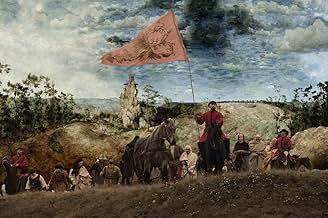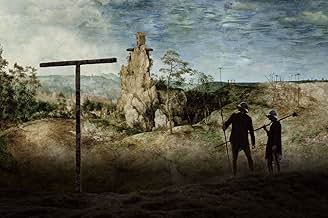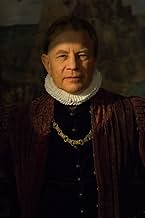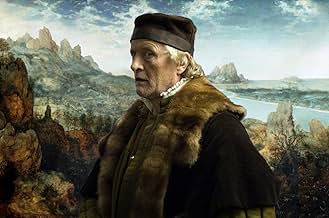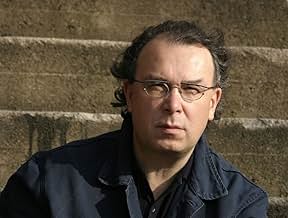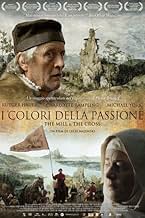IMDb RATING
6.8/10
4.6K
YOUR RATING
This movie focuses on a dozen of the five hundred characters depicted in Bruegel's painting. The theme of Christ's suffering is set against religious persecution in Flanders in 1564.This movie focuses on a dozen of the five hundred characters depicted in Bruegel's painting. The theme of Christ's suffering is set against religious persecution in Flanders in 1564.This movie focuses on a dozen of the five hundred characters depicted in Bruegel's painting. The theme of Christ's suffering is set against religious persecution in Flanders in 1564.
- Director
- Writers
- Stars
- Awards
- 10 wins & 7 nominations total
- Director
- Writers
- All cast & crew
- Production, box office & more at IMDbPro
Featured reviews
I really like when the come out with a film like this. I like costume dramas, but this one is so interesting because it was made based on a painting and it works with a very interesting subject of Protestantism in Flanders and tryouts of Spanish militia to eradicate it. Not a lot of the films was made about the subject, and it clearly shows desperation of the Spanish militia to eradicate, at that time, very strong Protestant movement in Flanders. How state of the affairs came to that? I would track it down to Pope Alexander VI Borgia and total corruption of the Curria of the late 1490s. It was inevitable that someone like Martin Luther to show up, and it was a downhill for the northern Europe from that time onwards as far as Roman Catholicism.
Beside that, cinematography is great and costimography as well. True holiday for the eyes. I enjoyed every moment of it.
Beside that, cinematography is great and costimography as well. True holiday for the eyes. I enjoyed every moment of it.
The Mill and the Cross (2011)
Maybe I anticipated this for too long, hearing about its production, and teaching in an Art History department myself. The result is both astonishing and boring as heck. I know, there is a kind of absorption that happens through silence and slow appreciation. And there is even the astonishment of looking without really thinking, or feeling, for the narrative or the characters.
This is, for sure, a visually wonderful movie. The way it works out the scenery and milieu of a period based on a single painting is brilliant and ambitious. The mise-en-scene might in fact be the only and singular point of it all. So on that level, eleven stars. Terrific. Mind-blowing.
But that exercise in naturalistic re-creation, in enlivening a masterpiece on canvas by Bruegel from 1564, is not, to me, enough. You will know after ten minutes whether to continue. I have heard of people being just spellbound by it all, so that hopefully would be your feeling.
I tried to make the characters have meaning on some level, either in their interactions, or in their actions alone, or through what they did to the world around them. Much of what happens feels more medieval than Renaissance, to me, but I'm sure that was researched thoroughly. (Bruegel was painting at a time when the Renaissance from Italy had made its way thoroughly north to the lowland countries and beyond.)
It is fun (and indicative of the seriousness here) that both Michael York and Charlotte Rampling took part, late in their careers. That was one of the draws, for sure. But don't expect revelations there, either. Expect in fact only what the director, Lech Majewski, intended—a film version of the painting, set in its larger context but always based on and drawing from this one admittedly fantastic painting. Which might be your starting point, before launching into this one and half hour homage.
Maybe I anticipated this for too long, hearing about its production, and teaching in an Art History department myself. The result is both astonishing and boring as heck. I know, there is a kind of absorption that happens through silence and slow appreciation. And there is even the astonishment of looking without really thinking, or feeling, for the narrative or the characters.
This is, for sure, a visually wonderful movie. The way it works out the scenery and milieu of a period based on a single painting is brilliant and ambitious. The mise-en-scene might in fact be the only and singular point of it all. So on that level, eleven stars. Terrific. Mind-blowing.
But that exercise in naturalistic re-creation, in enlivening a masterpiece on canvas by Bruegel from 1564, is not, to me, enough. You will know after ten minutes whether to continue. I have heard of people being just spellbound by it all, so that hopefully would be your feeling.
I tried to make the characters have meaning on some level, either in their interactions, or in their actions alone, or through what they did to the world around them. Much of what happens feels more medieval than Renaissance, to me, but I'm sure that was researched thoroughly. (Bruegel was painting at a time when the Renaissance from Italy had made its way thoroughly north to the lowland countries and beyond.)
It is fun (and indicative of the seriousness here) that both Michael York and Charlotte Rampling took part, late in their careers. That was one of the draws, for sure. But don't expect revelations there, either. Expect in fact only what the director, Lech Majewski, intended—a film version of the painting, set in its larger context but always based on and drawing from this one admittedly fantastic painting. Which might be your starting point, before launching into this one and half hour homage.
5lixy
This gorgeous reconstruction of Bruegel's painting is ultimately more impressive than inspiring. There is no character, no narrative, no emotion in this piece and there's not that much analysis, either, despite the director's claims. I just saw it at the SF Film Fest, and the likable and knowledgeable director gave a lengthy lecture a) on how long it took to find the fabric for the costumes and b) on the loss of our ability to read pictorial symbols. Sadly, the latter was not related to (or within) the film directly--that would have been interesting indeed!--and neither is the impressive (expensive) production design enough to make this work compelling.
If you are interested in symbology and art history, see Peter Greenaway's, far superior Nightwatching, a film with a plot and lively characters as well as a fascinating view into the meanings (and the USE of meanings and symbols) of another famous Dutch painting, which, despite also suffering from some bombastic elements, still manages to engage the viewer in its own right as a movie.
Also Derek Jarman's Caravaggio comes to mind as a film that uses tableaux to evoke the painter of the title. Despite--or perhaps due to--being somewhat opaque and strange, the Greenaway and Jarman films (and almost any of their work) are far more interesting than The Mill and the Cross, because they use the medium of film to SHOW and not TELL. This literal and slavish reproduction of the painting was impressive in its verisimilitude but ultimately pointless and superficial.
If you are interested in symbology and art history, see Peter Greenaway's, far superior Nightwatching, a film with a plot and lively characters as well as a fascinating view into the meanings (and the USE of meanings and symbols) of another famous Dutch painting, which, despite also suffering from some bombastic elements, still manages to engage the viewer in its own right as a movie.
Also Derek Jarman's Caravaggio comes to mind as a film that uses tableaux to evoke the painter of the title. Despite--or perhaps due to--being somewhat opaque and strange, the Greenaway and Jarman films (and almost any of their work) are far more interesting than The Mill and the Cross, because they use the medium of film to SHOW and not TELL. This literal and slavish reproduction of the painting was impressive in its verisimilitude but ultimately pointless and superficial.
10JvH48
Many thanks to the Rotterdam filmfestival 2011 for screening this guided tour through Christ Carrying the Cross, the painting by Pieter Bruegel the Elder. I learned a lot about the ideas behind it and the way it was set up. Seeing it explained gradually throughout the story, will let me remember it better than reading about it in a book.
We also learned a lot about how people lived those days. A special mention should be devoted to the parts where this film demonstrates that life goes on, regardless of politics, war, and religions. We also saw many forgotten customs about bread, threshold cleaning, and much more that I want to leave as an exercise to the close observer.
A dramatic moment at ¾ of the film is where the painter raises his hand, and life comes to a stand still, including the mill on the hill that stops by a hand signal of the miller. It seems no coincidence that the miller very much resembles how our Lord is pictured usually, and also that he oversees the whole panorama from his high position. As soon as he signals the mill to resume working, the whole picture relives from its frozen state.
A large part of the audience stayed for the final Q&A. We got much information about the post production effort required to get the colors right, and creating the different layers to get everything in focus. Further, the film maker told he wanted to make a feature film from the start. It was considered a Mission Impossible by the people around him. How wrong they were!
All in all, a lot goes on in the film, much more than I could oversee during the screening. Maybe I should try to grasp more of the fine details during a second viewing. I don't think I saw everything that the film makers did put into this production.
We also learned a lot about how people lived those days. A special mention should be devoted to the parts where this film demonstrates that life goes on, regardless of politics, war, and religions. We also saw many forgotten customs about bread, threshold cleaning, and much more that I want to leave as an exercise to the close observer.
A dramatic moment at ¾ of the film is where the painter raises his hand, and life comes to a stand still, including the mill on the hill that stops by a hand signal of the miller. It seems no coincidence that the miller very much resembles how our Lord is pictured usually, and also that he oversees the whole panorama from his high position. As soon as he signals the mill to resume working, the whole picture relives from its frozen state.
A large part of the audience stayed for the final Q&A. We got much information about the post production effort required to get the colors right, and creating the different layers to get everything in focus. Further, the film maker told he wanted to make a feature film from the start. It was considered a Mission Impossible by the people around him. How wrong they were!
All in all, a lot goes on in the film, much more than I could oversee during the screening. Maybe I should try to grasp more of the fine details during a second viewing. I don't think I saw everything that the film makers did put into this production.
I found this film to inspire the same contemplative mood and heightened awareness of similar films that build power without reliance on lots of dialogue, music or usual cinematic cues. If you appreciated "Into Great Silence" or "Vision" or "The Tree of Life" or even "2001" you will appreciate the poetic quality of this film. It is important for us to slow down occasionally and allow some films to affect us without the necessity of being slammed over the head with noise and speed and highly charged emotions. After all, for a film placed in its time, that is a more realistic portrayal of life during those centuries. This film illuminates the artistic process and aims of the artist. We are fortunate that the makers of this film dared to create this unique journey into a canvas of one of the world's great artists.
Did you know
- TriviaIn the movie, the two large paintings displayed behind Nicolaes Jonghelinck (Michael York) and his wife (Dorota Lis) in their house, are also works by Pieter Bruegel the Elder, "The Tower of Babel" (1563) and "Hunters in the Snow" (1565). They were indeed commissioned or at any rate owned by Jonghelinck at the time.
- GoofsA few minutes before the end of the movie, a red automobile crosses the background between two houses, while Bruegel and Nicholas Jonghelinck are speaking in the foreground.
- SoundtracksMiserere, Opus 44
By Henryk Mikolaj Górecki
Performed by the Silesia Philharmonic Choir (Chorus Master Jan Wojtacha)
- How long is The Mill and the Cross?Powered by Alexa
Details
- Release date
- Countries of origin
- Official site
- Languages
- Also known as
- The Mill and the Cross
- Filming locations
- Wieliczka, Malopolskie, Poland(mill interiors)
- Production companies
- See more company credits at IMDbPro
Box office
- Gross US & Canada
- $312,187
- Opening weekend US & Canada
- $11,354
- Sep 18, 2011
- Gross worldwide
- $1,116,180
- Runtime
- 1h 32m(92 min)
- Color
- Sound mix
- Aspect ratio
- 1.85 : 1
Contribute to this page
Suggest an edit or add missing content


